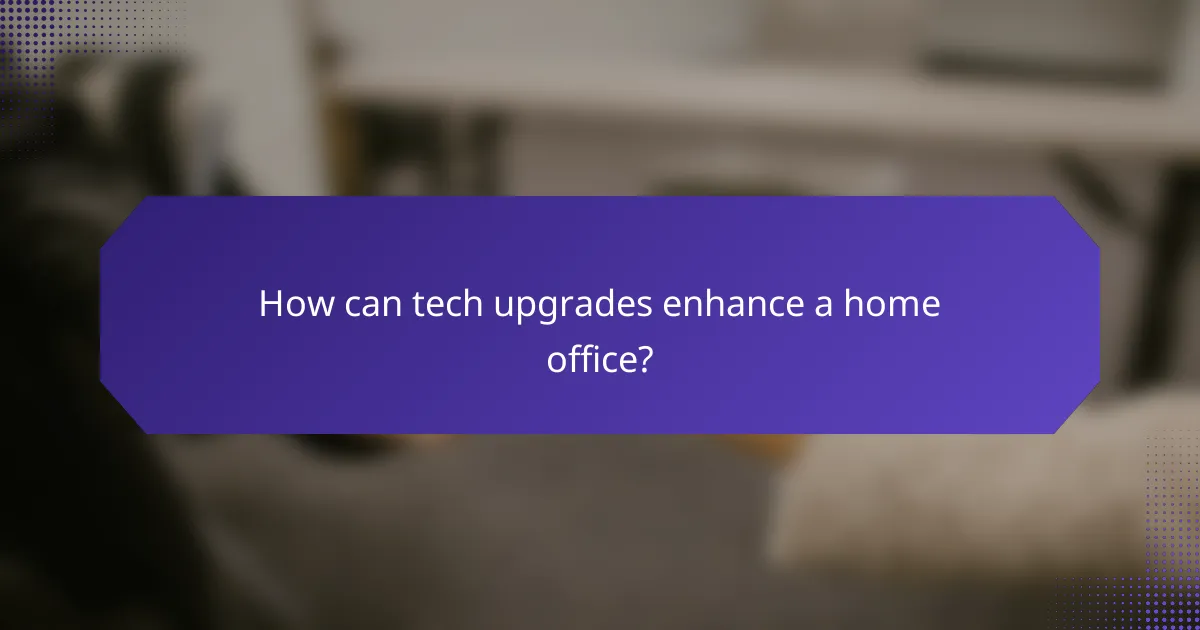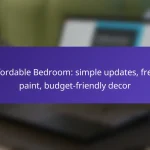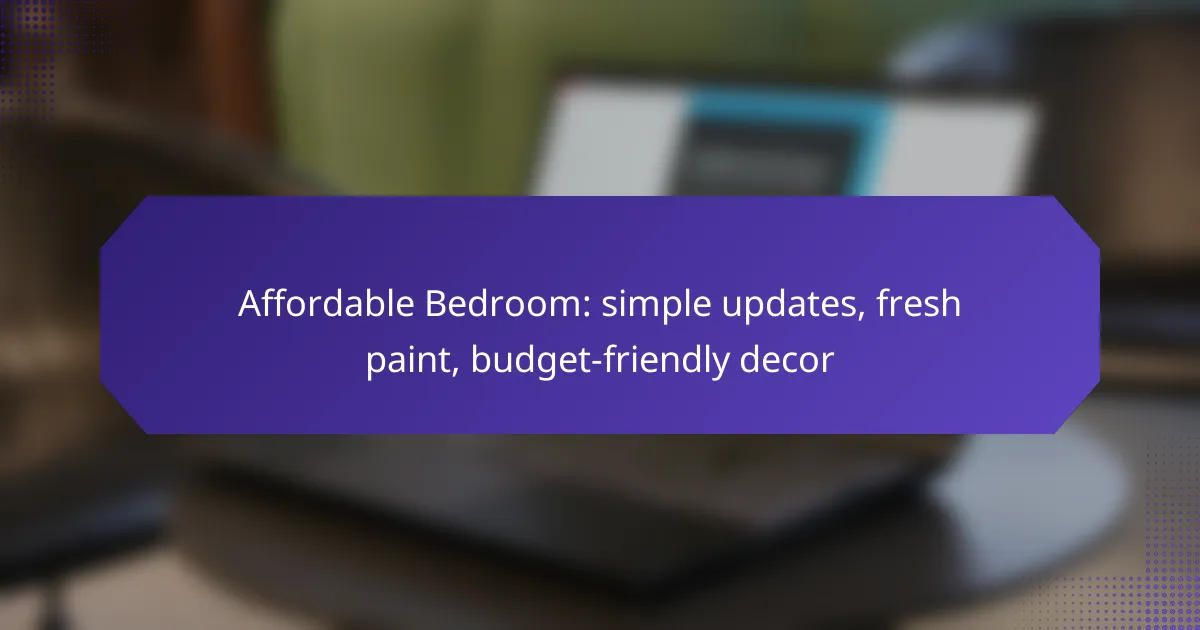Creating an expensive home office involves investing in ergonomic furniture, advanced tech upgrades, and effective soundproofing solutions. High-quality ergonomic chairs and desks enhance comfort and productivity, while tech enhancements like high-speed internet and ergonomic devices streamline your workflow. Additionally, soundproofing methods such as acoustic panels and soundproof curtains can minimize distractions, ensuring a focused and efficient work environment.

What are the best ergonomic furniture options for a home office in Canada?
The best ergonomic furniture options for a home office in Canada prioritize comfort, support, and adjustability. Investing in high-quality ergonomic chairs and desks can significantly enhance productivity and reduce the risk of discomfort during long working hours.
Herman Miller Aeron chair
The Herman Miller Aeron chair is renowned for its ergonomic design and adjustability. It features a breathable mesh material that helps regulate temperature and provides excellent lumbar support, making it suitable for extended use.
Consider the size options (A, B, and C) to fit your body type. The chair’s adjustable armrests and seat height allow for a customized fit, which is crucial for maintaining good posture.
Steelcase Leap chair
The Steelcase Leap chair is designed to support a wide range of postures, making it ideal for dynamic work environments. Its LiveBack technology allows the backrest to mimic the natural movement of your spine, providing continuous support.
With adjustable seat depth and arm height, this chair can accommodate various body shapes. It’s a solid investment for those who spend many hours at their desks.
Uplift V2 standing desk
The Uplift V2 standing desk is a versatile option that allows users to easily switch between sitting and standing. Its height adjustment range accommodates most users, promoting better posture and reducing fatigue.
Consider adding accessories like a keyboard tray or monitor arm to enhance ergonomics further. The desk’s stability and customizable options make it a popular choice among remote workers.
Fully Jarvis desk
The Fully Jarvis desk is known for its eco-friendly materials and smooth height adjustment. It offers a wide range of height settings, making it suitable for both sitting and standing positions.
Customization options include various desktop materials and sizes, allowing you to tailor it to your workspace. The desk’s sturdy construction ensures durability over time.
Flexispot E7 Pro Plus desk
The Flexispot E7 Pro Plus desk combines affordability with quality, offering a robust height adjustment mechanism. It supports a wide range of heights, making it accessible for most users.
This desk features a solid frame and a variety of desktop finishes, allowing for personalization. It’s an excellent choice for those looking to enhance their home office without breaking the bank.

How can tech upgrades enhance a home office?
Tech upgrades can significantly improve productivity and comfort in a home office. By investing in high-speed internet, ergonomic devices, and soundproofing solutions, you can create a more efficient and enjoyable workspace.
High-speed internet solutions
High-speed internet is crucial for seamless communication and efficient work processes. Consider options like fiber optic connections, which can offer speeds ranging from 100 Mbps to over 1 Gbps, depending on your location and provider.
When choosing an internet plan, evaluate your typical usage, including video conferencing and large file uploads. Aim for a plan that provides sufficient bandwidth for multiple devices to avoid slowdowns during peak usage times.
Ergonomic keyboards and mice
Ergonomic keyboards and mice are designed to reduce strain and enhance comfort during long working hours. Look for keyboards with a split design and adjustable height, which can help maintain a natural wrist position.
For mice, opt for models that fit your hand size and grip style. Features like adjustable sensitivity and programmable buttons can further enhance your workflow. Investing in these tools can lead to better posture and reduced risk of repetitive strain injuries.
Dual monitor setups
A dual monitor setup can greatly increase your productivity by allowing you to multitask more effectively. With two screens, you can have multiple applications open simultaneously, reducing the need to switch back and forth.
When setting up dual monitors, ensure they are at eye level to prevent neck strain. Consider using monitors of the same size and resolution for a more cohesive viewing experience. This setup can be particularly beneficial for tasks that require extensive data comparison or content creation.
Noise-canceling headphones
Noise-canceling headphones can create a quieter work environment, helping you focus better. These headphones use technology to block out ambient sounds, making them ideal for busy households or shared spaces.
When selecting noise-canceling headphones, look for features like comfort, battery life, and sound quality. Models that offer both active and passive noise cancellation can provide a versatile listening experience, whether you’re in a noisy café or at home.

What soundproofing methods are effective for home offices?
Effective soundproofing methods for home offices include acoustic panels, soundproof curtains, weatherstripping doors and windows, and rugs or carpets. Each of these solutions can significantly reduce noise levels, creating a quieter and more productive workspace.
Acoustic panels
Acoustic panels are designed to absorb sound waves, reducing echo and background noise. They can be mounted on walls or ceilings and come in various materials, including foam and fabric, which can blend with your office decor.
When choosing acoustic panels, consider the size of your office and the level of noise you experience. Panels should cover a significant portion of the walls to be effective, and you might need multiple panels depending on the room’s acoustics.
Soundproof curtains
Soundproof curtains are made from dense materials that block outside noise while also providing insulation. These curtains can be an easy addition to your home office, especially if you have large windows that let in sound.
Look for curtains labeled as “soundproof” or “acoustic,” which typically have a heavier fabric and may include multiple layers. Ensure they cover the entire window area to maximize their effectiveness.
Weatherstripping doors and windows
Weatherstripping is a simple yet effective method to seal gaps around doors and windows, preventing sound leakage. This can be particularly useful in older homes where gaps may be more pronounced.
Choose adhesive weatherstripping tape or foam seals that are easy to install. Ensure a snug fit to block noise from outside effectively, and check for any wear and tear periodically to maintain soundproofing quality.
Rugs and carpets
Rugs and carpets add an extra layer of sound absorption in your home office, helping to reduce noise from footsteps and other sounds. They can be particularly effective on hard flooring surfaces like tile or hardwood.
Select thick, plush rugs for the best sound-dampening effect. Consider placing rugs in high-traffic areas or under your desk to minimize noise disturbances while you work.

What are the costs associated with upgrading a home office?
Upgrading a home office can involve significant expenses, particularly for ergonomic furniture, technology enhancements, and soundproofing materials. Understanding these costs helps in planning a budget that meets both comfort and productivity needs.
Budget for ergonomic furniture
Investing in ergonomic furniture is essential for comfort and health while working from home. A good ergonomic chair typically ranges from $200 to $1,500, while desks can cost between $300 and $1,200, depending on features like height adjustability.
When budgeting, consider additional items such as keyboard trays, monitor stands, and footrests, which can collectively add another $100 to $500. Prioritize quality to ensure long-term benefits and avoid potential health issues.
Tech upgrade expenses
Upgrading technology can significantly enhance your home office experience. Essential items include a reliable computer, which may cost between $500 and $2,500, and peripherals like monitors, keyboards, and mice, which can add another $200 to $1,000.
Don’t overlook software subscriptions and cloud services, which can range from $10 to $50 monthly. Investing in high-speed internet is also crucial, with costs varying from $50 to $100 per month depending on your location and service provider.
Soundproofing material costs
Soundproofing your home office can improve focus and productivity by minimizing distractions. Basic soundproofing options, such as acoustic panels, can range from $20 to $100 each, while more comprehensive solutions like soundproof doors or windows may cost several hundred to a few thousand dollars.
Consider DIY options for cost savings, such as using heavy curtains or rugs, which can be effective at a lower price point. Overall, budget between $200 and $1,500 for a well-soundproofed office, depending on the extent of the upgrades needed.

How to choose the right ergonomic furniture for your needs?
Selecting the right ergonomic furniture involves understanding your specific requirements and workspace. Focus on comfort, adjustability, and support to enhance productivity and reduce strain during long hours of work.
Assessing your workspace
Begin by evaluating your workspace dimensions and layout. Measure the area where you plan to set up your home office, considering both the available space and the furniture you intend to use. This will help you determine the size and type of ergonomic furniture that fits best.
Next, consider your work habits and tasks. If you spend significant time on a computer, prioritize a chair with lumbar support and a desk that allows for proper screen height. For those who alternate between sitting and standing, a height-adjustable desk can be beneficial.
Finally, think about additional factors such as lighting and noise levels. A well-lit space can reduce eye strain, while soundproofing elements like acoustic panels can enhance focus. Assessing these aspects will guide you in selecting furniture that complements your overall workspace environment.










